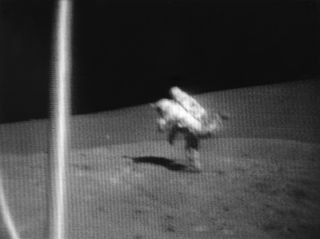Falling on the Moon: How Much Gravity Do Astronauts Really Need?
For all the heroics of space travel, life as an astronaut comes with an array of indignities. Adult diapers. Pee funnels. And then there are the awkward tumbles on the moon for all the world to see.
In one famous episode from NASA's Apollo 17 mission in 1972, moonwalker Jack Schmitt topples over — seemingly in slow motion — as he fumbles a sample collection bag while bounding across the lunar surface. Back at Mission Control in Houston, Capcom Bob Parker calls out to Schmitt's fellow moonwalker, Gene Cernan, "Hey, Gene, would you go over and help Twinkletoes, please?"
NASA's records from the Apollo era contain pages and pages of such deadpan accounts of lunar spills. Mission controllers spent hours analyzing video footage to try to figure out why the astronauts lost balance and what techniques they used to get back up. Forty years later, new experiments might help explain why the Apollo astronauts occasionally struggled to stay upright. [The Human Body in Space: 6 Weird Facts]

Humans need at least 15 percent of the level of gravity found on Earth to orient themselves, according to findings published yesterday (Sept. 3) in the journal PLOS ONE. That means the level of gravity on the moon — about 17 percent of Earth's gravity — is just barely strong enough to provide adequate cues for astronauts to know which way is up.
No one has been back to the moon since Cernan and Schmitt blasted off the lunar surface in December 1972. But scientists have ways to simulate the low-gravity environment of the moon without leaving Earth.
Five men and five women participated in the experiment at the European Space Agency's Short Arm Centrifuge Facility (SAHC) in Cologne, Germany. The participants lied down on a platform in the human centrifuge with their feet facing away from the center. Depending on how fast the machine spun, the recruits experienced different levels of gravity, from 0g, close to the weightless environment in orbit, to 1g, the force humans feel while standing on Earth, explained study leader Laurence Harris of York University in Canada.
While whirling around in the centrifuge, the participants took a perceptual test, in which they had to choose whether the tilted letter they were looking at on a circular computer screen was a "p" or "d." In a near-zero-gravity environment, such as the International Space Station, astronauts need to rely on visual cues alone to orient themselves, Harris said. The results of the experiment found that gravity only starts influencing a person's sense of up and down once it hits about 0.15g.
Get the Space.com Newsletter
Breaking space news, the latest updates on rocket launches, skywatching events and more!
"In a low gravitational field, such as on the moon, you'll have an unreliable estimate for what gravity's telling you is up," Harris told Space.com. In retrospect, he said, it's not surprising that a YouTube search for "astronauts falling over" yields so many results.

"It's just really important that we understand our sensory systems before we go into extreme environments," Harris said.
There is good news for space program managers with their sights set on Mars: With 38 percent of Earth's gravity, the Red Planet's gravity should be sufficient for astronauts to easily orient themselves and maintain balance, the researchers said.
Follow Megan Gannon on Twitter and Google+. Follow us @Spacedotcom, Facebook or Google+. Originally published on Space.com.
Join our Space Forums to keep talking space on the latest missions, night sky and more! And if you have a news tip, correction or comment, let us know at: community@space.com.

Megan has been writing for Live Science and Space.com since 2012. Her interests range from archaeology to space exploration, and she has a bachelor's degree in English and art history from New York University. Megan spent two years as a reporter on the national desk at NewsCore. She has watched dinosaur auctions, witnessed rocket launches, licked ancient pottery sherds in Cyprus and flown in zero gravity on a Zero Gravity Corp. to follow students sparking weightless fires for science. Follow her on Twitter for her latest project.
